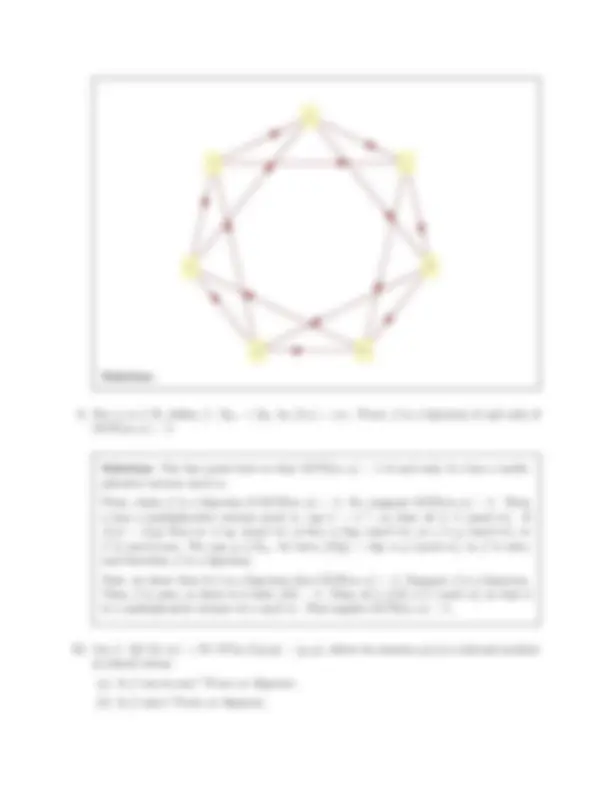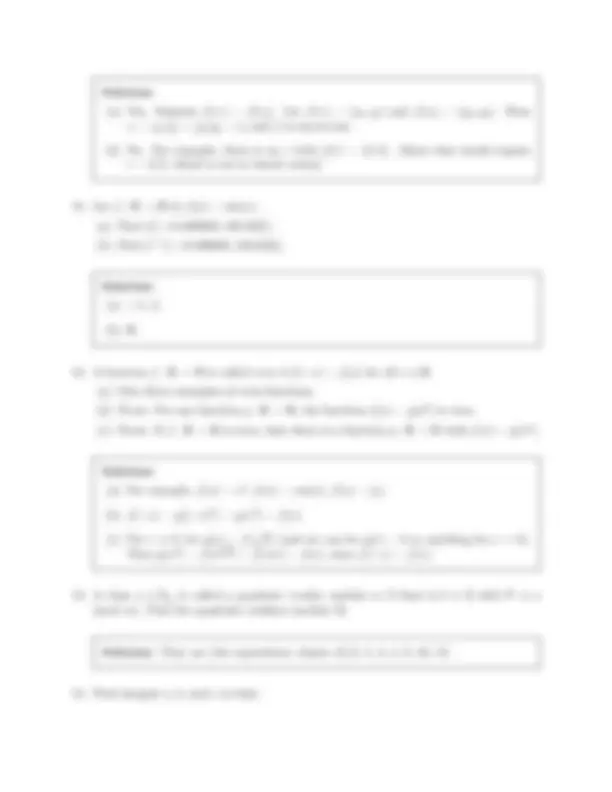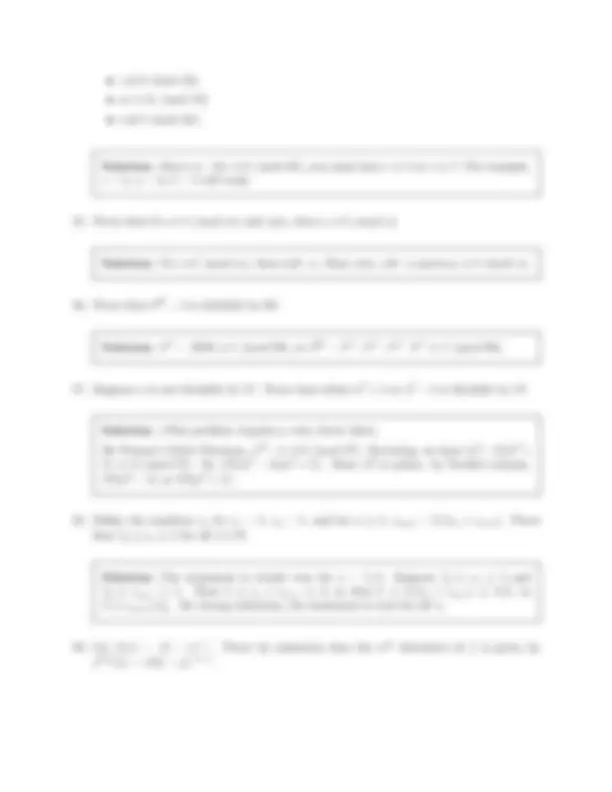





Study with the several resources on Docsity

Earn points by helping other students or get them with a premium plan


Prepare for your exams
Study with the several resources on Docsity

Earn points to download
Earn points by helping other students or get them with a premium plan
Community
Ask the community for help and clear up your study doubts
Discover the best universities in your country according to Docsity users
Free resources
Download our free guides on studying techniques, anxiety management strategies, and thesis advice from Docsity tutors
Material Type: Exam; Professor: Clair; Class: Principles of Mathematics; Subject: Mathematics; University: Saint Louis University; Term: Unknown 1989;
Typology: Exams
1 / 6

This page cannot be seen from the preview
Don't miss anything!




Math 266 - Final Exam Practice Questions
Solution: If p does not divide a, then p does not divide a^2.
Solution: ∼ (∼ P ∧ ∼ Q)
Solution: This problem is hard, because it can’t be done with simple arithmetic. Instead, you need to use a fact about real numbers that can only be proved from the definition of real numbers (which we didn’t cover). The fact you need is that for any real number x, there is an integer n with x < n. Or, equivalently, you can use the greatest integer function. Try again to prove it using this hint. Here is a proof: Suppose x, y ∈ R and x < y. Choose an integer n > (^) y−^1 x , so that (^1) n < y − x. Then ny − nx > 1, so there is an integer m with nx ≤ m ≤ ny (you could let m be bnxc + 1). Then x ≤ mn ≤ y and we have shown that the rational number mn is between x and y.
max(x, y) =
x if x ≥ y; y if y > x. Prove, for any z ∈ R, that if z ≥ x and z ≥ y, then z ≥ max(x, y).
Solution: Suppose z is as described. If x ≥ y then z ≥ x = max(x, y). If y > x, then z ≥ y = max(x, y). In both cases, z ≥ max(x, y).
Solution: Define, for x, y ∈ R:
min(x, y) =
y if x ≥ y; x if y > x.
We handle three cases. If x = y, min(x, y) = x = −(−x) = − max(−x, −y). If x > y, then −x < −y, so − max(−x, −y) = −(−y) = y = min(x, y). If x < y, then −x > −y, so − max(−x, −y) = −(−x) = x = min(x, y).
( (^) ∞ ⋂
n=
An
n=
Bn
n=
An ∪ Bn.
Solution: Let x ∈ (
n=1 An)^ ∪^ (
n=1 Bn). Then^ x^ ∈^ (
n=1 An) or^ x^ ∈^ (
n=1 Bn). If x ∈ (
n=1 An) then^ x^ ∈^ An^ for all^ n, therefore^ x^ ∈^ An^ ∪^ Bn^ for all^ n, and so x ∈
n=1 An^ ∪^ Bn. If^ x^ ∈^ (
n=1 Bn) then^ x^ ∈^ Bn^ for all^ n, therefore^ x^ ∈^ An^ ∪^ Bn for all n, and so x ∈
n=1 An^ ∪^ Bn.
Solution: Suppose xSy. Then xRy or yRx. Therefore yRx or xRy. So ySx, and so S is symmetric.
Solution: (a) Yes. Suppose f (r 1 ) = f (r 2 ). Let f (r 1 ) = (p 1 , q 1 ) and f (r 2 ) = (p 2 , q 2 ). Then r 1 = p 1 /q 1 = p 2 /q 2 = r 2 and f is one-to-one.
(b) No. For example, there is no r with f (r) = (2, 2). (Since that would require r = 2/2, which is not in lowest terms).
(a) Find f ([− 14. 000001 , 182 .632]). (b) Find f −^1 ([− 14. 000001 , 182 .632]).
Solution: (a) [− 1 , 1].
(b) R.
(a) Give three examples of even functions. (b) Prove: For any function g : R → R, the function f (x) = g(x^2 ) is even. (c) Prove: If f : R → R is even, then there is a function g : R → R with f (x) = g(x^2 ).
Solution: (a) For example, f (x) = x^2 , f (x) = cos(x), f (x) = |x|.
(b) f (−x) = g((−x)^2 ) = g(x^2 ) = f (x).
(c) For x ≥ 0, let g(x) = f (
x) (and we can let g(x) = 0 or anything for x < 0). Then g(x^2 ) = f (
x^2 ) = f (±x) = f (x), since f (−x) = f (x).
Solution: They are (the equivalence classes of) 0, 1, 3, 4, 9, 10, 12.
Solution: Since (a − b)c ≡ 0 (mod 35), you must have c ≡ 5 or c ≡ 7. For example, c = 5, a = 8, b = 1 will work.
Solution: If a ≡ b (mod m), then m|b−a. Since n|m, n|b−a and so a ≡ b (mod n).
Solution: 211 = 2048 ≡ 1 (mod 89), so 2^44 = 2^11 · 211 · 211 · 211 ≡ 1 (mod 89).
Solution: (This problem requires a very clever idea). By Fermat’s Little Theorem, a^16 − 1 ≡ 0 (mod 17). Factoring, we have (a^8 − 1)(a^8 +
Solution: The statement is clearly true for n = 1, 2. Suppose 1 / 2 ≤ cn ≤ 1 and (^1) / 2 ≤ cn+1 ≤ 1. Then 1 ≤ cn + cn+1 ≤ 2, so that 1 ≥ 1 /(cn + cn+1) ≥ 1 /2, so 1 ≥ cn+2 ≥^1 / 2. By strong induction, the statement is true for all n.